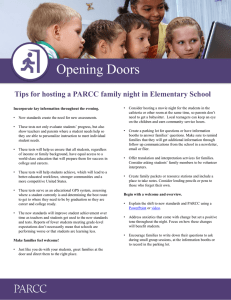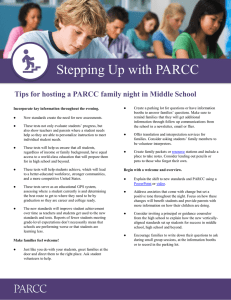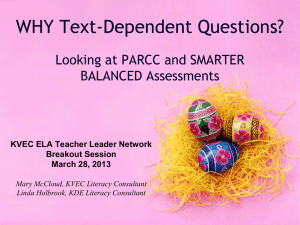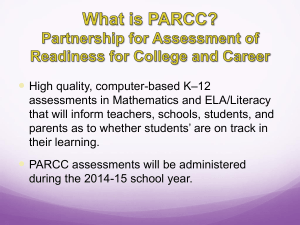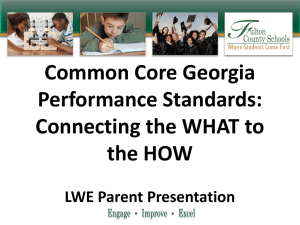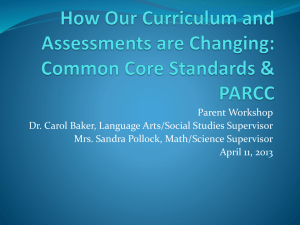PARCC-ELA Presentation - Harding Township School
advertisement
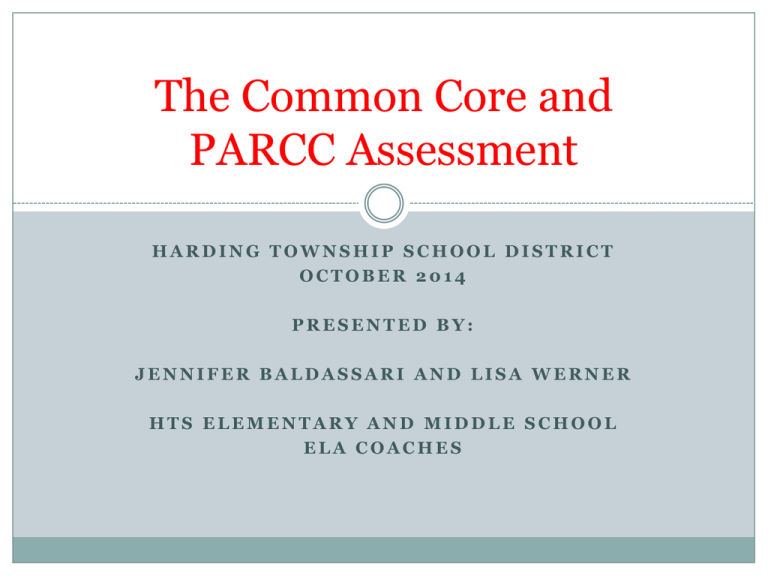
The Common Core and PARCC Assessment HARDING TOWNSHIP SCHOOL DISTRICT OCTOBER 2014 PRESENTED BY: JENNIFER BALDASSARI AND LISA WERNER HTS ELEMENTARY AND MIDDLE SCHOOL ELA COACHES What is the Common Core? Three-Minute Video Explaining the Common Core State Standards How Are the CCSS Different? Include rigorous content and application of knowledge through higher-order thinking skills Provide performance-based collaborative activities and assessments Integrate literacy across content areas including Science and Social Studies Place stronger emphasis on informational text, research, and media skills Instructional Shifts in ELA 6 Shifts in ELA Read as much nonfiction as fiction Learn about the world by reading Read more challenging material closely Discuss reading using evidence Write non-fiction using evidence Increase academic vocabulary ELA Shift 1: Read as Much Non-Fiction as Fiction Students Must... Parents Can… Read more non-fiction Supply more non-fiction Know the ways non-fiction can be put together Read and discuss more non-fiction with your child Enjoy and discuss the details of nonfiction Have fun with non-fiction in front of children ELA Shift 2: Learn About the World by Reading Students Must… Parents Can… Build proficiency in Science and Social Studies through reading Supply series of text on topics of interest Handle “primary source” documents Find books that explain Get “smarter” through text Discuss non-fiction text and the ideas within ELA Shift 3: Read More Complex Material Carefully Students Must… Parents Can… Re-Read Provide more challenging text that students WANT to and can read Read material at comfort level AND work with more challenging text Know grade level/reading level appropriate text Unpack text Read challenging text with student Handle frustration and keep pushing Show that challenging text is worth unpacking ELA Shift 4: Discuss Reading Using Evidence Students Must… Parents Can… Find evidence to support their arguments Talk about text Form judgments Demand evidence in every day discussions/disagreements Become scholars Read aloud or read the same book and discuss with evidence Discuss authors’ point of view ELA Shift 5: Discuss Reading Using Evidence Students Must… Parents Can… Make arguments in writing using evidence Encourage writing at home Compare multiple texts in writing Write “books” together and use evidence/details Write well ELA Shift 6: Academic Vocabulary Students Must… Parents Can… Learn the words that they can use in college and career Read often and constantly with your children Get smarter about using “language of power” Provide multiple books on the same topic Talk to your children about reading Listen to your children read Play word and rhyming games with your children New Standards = New Test PARCC tests are aligned to the new Common Core State Standards now in place in K-12 schools nationwide In most states, the outgoing tests were NOT linked to these more rigorous reading, writing and math standards The CCSS are designed to better prepare students for college and the workforce Why New Assessments Now? Current state assessments were not designed to: Assess and signal whether students are on track for success in college or careers Produce timely, actionable data for students, teachers and parents Test key skills, such as critical thinking and ability to problem solve Online Tests for an Online Era PARCC tests are computer-based and more engaging and innovative than outgoing paper and pencil state tests PARCC is flexible; can be administered on a variety of devices that schools can use for instruction Some PARCC features: highlighting, customizing colors, text to speech, captions for audio What is PARCC Partnership for Assessment of Readiness for College and Careers ETS is the developer Pearson is the assessment provider Content will include ELA and Math PARCC Priorities Determine whether students are college and career ready or on track Connect to the Common Core Standards Measure the full range of student performance, including that of high and low achieving students Provide educators data throughout the year to inform instruction Create innovative 21st Century, technology-based assessments Be affordable and sustainable How Will PARCC Be Different Students: Will know if they are on track to graduate ready for college/careers Teachers: Will have earlier access to data to plan for learning and instruction for the following year Parents: Will have clear and timely information about student progress States: Will have valid results that are comparable across borders How Will PARCC Be Different For Teachers and Schools: Computer-based testing will boost student engagement and scores More efficient than pencil-paper Timely data during the year will aid instruction, professional development Tests will assess the full range of student performance Tests will measure student growth at all levels as well as measuring proficiency PARCC Assessments PARCC assesses two formal times during the school year: 75% and 90% Performance Based Assessments (PBA): EBSR, TECR, AND PCR End of Year Assessments (EOY) –EBSR and TECR; questions designed in a way that they will draw students into deeper encounters with the text and will result in more comprehension of the topics ITEMS EXPLAINED EBSR – Evidence Based Selected Response: Combines a selected response question with a second one that asks students to show evidence from the text TECR – Technology Enhanced Constructed Response: Uses technology to capture student comprehension of texts in an authentic way that have been difficult to score by machine (e.g. drag and drop, shade text, move items to show relationships) PCR – Prose Constructed Response: Requires the evidence that students have understood texts they have read and can communicate that knowledge. PCR – 3 Types (March Test) Literary Analysis Task – Hones the student’s ability to read complex test closely; asks students to carefully consider literature worthy of close study and create an analytic essay Narrative Task – Students may be asked to write a story, detail a scientific process, write a historical account or describe an account of events based on the reading just completed. Research Simulation Task – students will analyze an informational topic presented through articles or multimedia. Students will answer a series of questions and synthesize the information in order to write two analytic essays- such as analyze the relationship between a series of concepts or weight two to three arguments and judge which is the most credible or analyze data from several illustrations or graphs. Writing Forms for PCR items In Grades 3-8 students may be asked to analyze and produce: Adventure, science fiction, fantasy, humorous or short stories Fiction, prequels, sequels Autobiography or biography Speeches, persuasive letters and essays Book reviews Brochures, letters, reports and reviews Character sketches, personal narratives Descriptions , how-to articles and other informational text Diaries/journals Wiki entries, science articles Explanations. Reports, essays Fables, myths or legends Scenes from plays Poetry Students must know RAFT before writing-reason, audience, format, topic Reading and Writing…. TLWBAT Show they can read and understand complex passages Write persuasively Conduct research and present findings Demonstrate speaking and listening skills Old Test vs. New Test Third Grade Narrative writing prompt on an old, outgoing state test…. Read the writing prompt below and complete the writing activity: Jump out of bed! Look out the window! It is a perfect weather day! Write a story about a day when the weather seemed perfect. Third Grade Narrative writing prompt on the PARCC You have read two texts about famous people in American history who solved a problem by working to make a change. Write an article for your school newspaper describing how Eliza and Carver faced challenges to change something in America In your article, be sure to describe in detail why some solutions they tried worked and others did not Tell how the challenges each on faced were the same and how they were different. Old Test vs. New Test 7th Grade NJASK Expository Essay Explain the benefits and challenges of living in your town or city. Be sure to include specific details in your answer. 7th Grade Literary Analysis Essay for PARCC You have just read a passage from The Count of Monte Cristo as well as a scene from the play Blessings. Think about the similarities and differences in how the two authors develop the themes in each text. Write an essay in which you identify a theme from each text and analyze how each theme is developed. Be sure to include specific details from both examples. Old Test vs. New Test 7th Grade Narrative Task for PARCC 7th Grade NJASK Narrative Task You discover that you left your cellphone at school. The building is locked. What do you do next? Use descriptive language and a beginning, middle and end to guide the writing of your story. At the end of the passage from “The Fast and the Furriest,” Howie tells Kevin that he is not making a good case. Write an original story that describes what Kevin does next, to try to change Howie’s mind about paying for Cromwell’s training. In writing your story: Consider what actions Kevin might take or say, to strengthen his case. Be sure to use what you have learned about setting, characters, and plot of the passage. Old Test vs. New Test 7th Grade NJASK Research Task Not tested on NJASK 7th Grade Research task for PARCC You have learned about electricity by reading two articles; “Energy Story” and “Conducting Solutions,” and viewing a video clip entitle “Handson Science with Squishy Circuits.” In an essay, compare the purposes of the three sources. Then analyze how each source uses explanations, demonstrations, or descriptions of experiments to help accomplish its purpose. Be sure to discuss important differences and similarities between the information gained from the video and the information provided in the articles. Support your response with evidence from each source. Sample PARCC Layout PARCC Sample Questions…… Grades ELA 3-5 Practice Questions 6-8 Practice Questions


